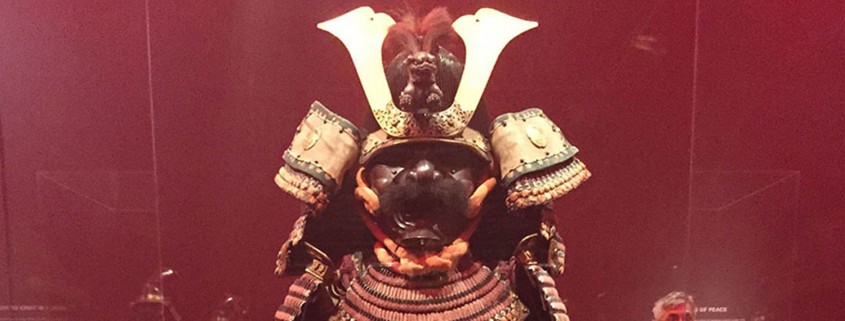LACMA samurai exhibit captures Japanese history
The first sight upon entering the samurai exhibition at the Los Angeles County Museum of Art is that of three warriors, charging into battle on horseback, both man and beast adorned with extravagant armor. Dramatic yet unobtrusive red light bathes the 140 pieces of samurai war regalia, creating an intense and lavish atmosphere. This powerful visual sets the tone for the whole exhibit. “Samurai: Japanese Armor from the Ann and Gabriel Barbier-Mueller Collection” is both striking and deeply interesting, with the ornate pieces of armor and weaponry accompanied by details of Japan’s history and culture.
The pieces themselves are impressive, with the armor on display acting not only as physical protection, but also as decoration and fanfare. Intricate detail, designed to allow more fluid movement than pure metal could, and elegant gold and red pieces create quite the arresting spectacle. The objects range from human armor, to horse saddles and masks carved to look like dragon heads, to helmets adorned with antlers. These helmets, while initially odd to observe, have an interesting story. Labeled an “Eboshi-shaped helmet,” it was a traditional headdress presented to young samurai warriors at the age of 12 as part of a coming-of-age ceremony. Gold lacquer coats the horns, adding to the extravagant effect.
The history of the samurai warrior is also explained through short paragraphs scattered throughout the exhibition. The role of the samurai came into existence after Japan put an end to obligatory military service in 792. This led to a more private mode of defense, and landowners employed their own forces for defense and protection of their land. Thus, the samurai class was born.
The samurais were more than just soldiers for provincial landowners however. The term samurai itself came to identify warriors who were skilled and educated and often joined Japan’s intellectual elite. Following the dissolution of the samurai class, many went on to hold positions in administration and government.
The costume or armor of a samurai warrior was the main identifiable symbol of his status. The armor was made up of three key components: a helmet or kabuto, a mask or mengu, and the chest armor or dõ. Shoulder guards, sleeves, a skirt, thigh protection and shin guards completed the ensemble that was, despite its ornateness, very light in comparison to most Western armor at the time. Materials used included iron, brocade, leather, lace and precious metals, and the armor took several months to produce. One of the pieces showcased from this period is a full suit of armor, equipped with elaborate gold leaf decorations on the helmet, a long, traditionally curved gold sword and a fan painted with an image of the Japanese flag. The rarity of full suits of armor like this certainly makes the exhibition unique and exceptional. As previously stated, however, the armor was as much a decorative piece of fashion as physical protection in battle, and never was this truer than in the peaceful Edo period between 1615 and 1868. The samurai did not lose their elite status during this period and became bureaucrats instead. It was unclear to the samurai whether this state of peace would last, and so they remained in battle-ready condition, which involved maintaining their armor as well. During this time, the armor was used for pageantry, decoration and exposition, for example in parades and processions. One example of this in the exhibition is the “The Armor of the Okegawadō Type,” featuring gilt decorations that reach six feet and convey the prestige and glamour of the samurai warrior. The exhibition itself is laid out somewhat like an elegant, stately fashion show, capturing the formal and dignified image of samurai culture. Another piece is the helmet which represents the flaming jewel. The helmet is decorated with metallic flames and has gold and bronze embellishments, adding to the luxurious image of the armor.
One of the highlights of the exhibition is a timeline of events in Japan and the West, thus providing an insight into the country’s overall history as well as the samurai culture. Key examples include the introduction of Buddhism in Japan around 552, very close to the year when Christianity was recognized in the Roman Empire in 313.
Together, the visual and literary elements of the exhibition provide a comprehensive overview of samurai culture, regalia and history. The exhibit only takes up one small room, and the information is presented in digestible sections, with the pieces well-spaced to avoid any sense of overcrowding. The color scheme clearly centers on red, the color of the sun in Japanese lore and the image on their flag. This sets a tone of elegance and lavishness alongside warfare and bloodshed, which is the essence of samurai culture. This exhibition is definitely worth a look if you are planning on paying LACMA a visit -— it is quick to explore and provides and fascinating glimpse into Japanese culture and history.
“Samurai: Japanese Armor from the Ann and Gabriel Barbier-Mueller Collection” will be available to view at LACMA until Feb. 1.

